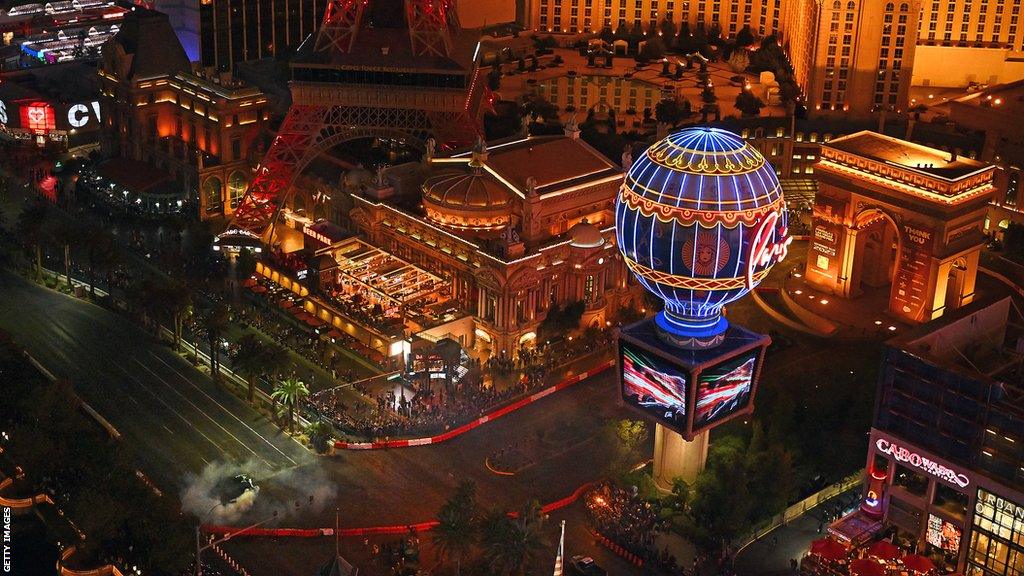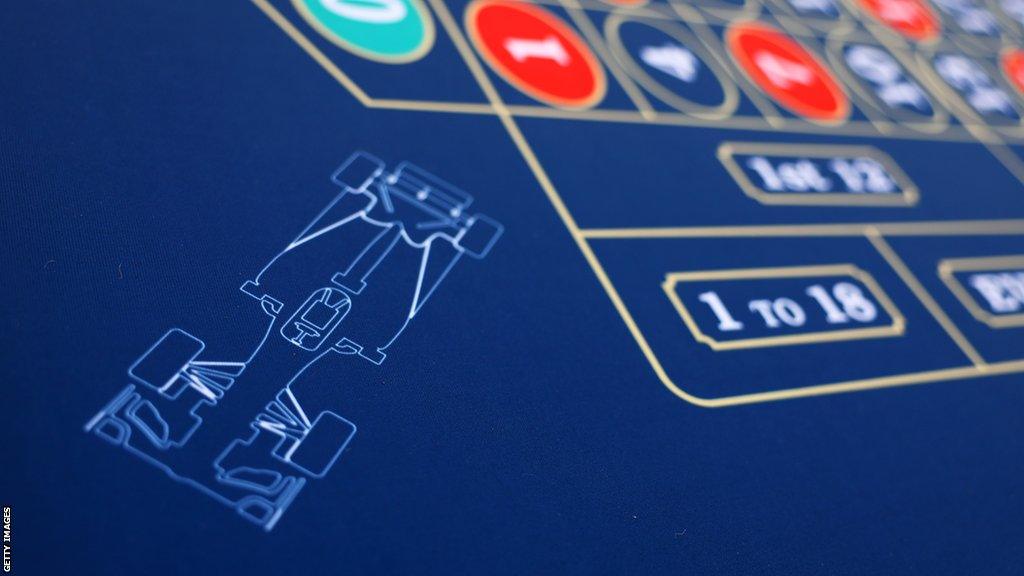Las Vegas Grand Prix: How a plan 40 years in the making finally came to fruition
- Published
- comments

The Las Vegas Grand Prix will pick its way around some of the city's most iconic locations
A plan 40 years in the making finally becomes reality this weekend, when Formula 1 holds a grand prix on the famous Las Vegas Strip.
F1 is going all out to make an impression. It hopes to create the most spectacular event the sport has ever staged, and has so far spent more than £500m on the Las Vegas Grand Prix.
That outlay includes £196m on buying a plot of land, and a further £327m on erecting a permanent pit building and preparing the track.
A lavish opening ceremony has been planned for Wednesday, with a host of music stars, including Kylie Minogue, Andra Day, Keith Urban and Journey, and featuring appearances by all the teams and drivers.
The race will be held on a 3.85-mile track around the Las Vegas streets, the centrepiece of which is a two-kilometre (1.24-mile) run down the famous Strip, home of all the major casino hotels.
The city is expecting 105,000 spectators on each of the three days of track action, culminating in the grand prix itself, unusually running on a Saturday night and with a start time of 22:00 (06:00 GMT on Sunday).
F1 chairman and chief executive officer Stefano Domenicali said: "It is going to look incredible on TV and will be an unforgettable event to be at in person."
Greg Maffei, president and chief executive officer of F1's parent company Liberty Media, added: "One of the goals with Vegas is to raise the bar. A night race down the Strip on a Saturday is going to be a whole other level of appeal and attraction and promotion for the United States audience, and the world audience."
The city's hotels have seen a chance to make big money. One example of the many high-end hospitality packages on offer is the Fountain Club, built on the famous water-and-light show at the Bellagio. Tickets start at a cool £9,186 per person.
Boom in the USA - finally
This is not the first grand prix to be held in Las Vegas. In 1981 and 1982, a race was staged on a track built in the parking lot of the Caesars Palace hotel. It was not a success, despite hosting the championship climax both years.
After that, former F1 boss Bernie Ecclestone tried to organise a race in the city that included the Strip, but it always foundered on opposition from the powerful casinos.
For a time, it looked as if F1 might never find a home in the US, or fully establish itself in the market there, despite Ecclestone's efforts.
He organised a succession of street races in Detroit, Dallas and Phoenix, and a race on a road course within the Indianapolis Motor Speedway, which finally collapsed as a result of a scandal in 2005, when only six cars started because of a problem with tyres., external
Looking back, Ecclestone finally hit gold with the United States Grand Prix in Austin, Texas. But that event took some years to fully establish itself, and by the time Liberty Media took over F1 in early 2017 - in a deal that valued the sport at £6bn - questions about whether it could succeed in the US were very much alive.
That was only a few months after Austin promoter Bobby Epstein finally hit on the method by which he would make his race sustainable.
Epstein wanted to broaden the event's appeal beyond racing fans, and in 2016 Taylor Swift played a concert at the US Grand Prix.
Over the succeeding years, the plan instigated with Swift - of pushing the racing timetable later in the day so people could watch the track action then stay for a concert by a major music star - solidified into a strategy that became a major success. But in 2017, it could not be known it would work as well as it has.
Liberty was concerned it was not seeing the impact it wanted in the US, and set about trying to come up with ideas that could make a difference.
The first was a race in Miami, which finally made its debut in 2022, albeit not in the form Liberty had originally intended.
That race happened just a few months after something of a eureka moment, when Liberty finally realised it could make a success of the States.
In October 2021, Austin was the first grand prix held outside Europe and the Middle East since the beginning of the pandemic. It was a massive hit.
Austin was already one of the most popular grands prix on the calendar, but F1 regulars who went to Texas that year were blown away by the impact the race had in the city - the increase in the number of people, and how many were obviously there as committed F1 fans, strolling around the city going to the bars, restaurants and live music venues wearing team merchandise.
It was evidence the combination of a post-Covid return to watching sport, the dramatic 2021 title fight between Lewis Hamilton and Max Verstappen, the impact of the Netflix Drive to Survive documentary series, and F1's greater social media and cultural presence had had a boom effect in the USA.
How Vegas got over the line
Work on the race in Las Vegas was already under way by then - F1's Las Vegas Grand Prix chief executive officer Renee Wilm told BBC Sport: "While Las Vegas has been top of mind for many years, conversations progressed in earnest during the spring of 2021."
As talks developed over the following months, and other senior F1 figures were able to join following a sports-wide exemption to Covid-related immigration restrictions, F1's obvious commitment to Las Vegas in financial terms was a key influence.
Wilm said: "Resort properties were open to engaging in these discussions because the race would be backed by Liberty Media - a well-known American public company founded by cable pioneer John Malone.
"Popularity of F1 has surged in recent years, with meaningful growth in the US market - which wasn't the case decades ago.
"With the doors opened, conversations quickly turned to excitement over the scale of this event and questions about logistics, including traffic planning, temporary bridge construction and overall people movement.
"Throughout all of these meetings, there was always an understanding that if any town could pull off an event of this calibre, it was Las Vegas."
Once local leaders saw the vision and potential, including the investment by F1 of so much capital expenditure in the city, the benefits came into focus. It became clear to the hotels that maxing out capacity, hosting hospitality and driving footfall to their venues over that weekend would have a significant effect.
It is expected the grand prix will generate £1-£1.3bn. And if that sounds outlandish, bear in mind the US Grand Prix has brought £8.2bn of out-of-state money to the Texas economy since its debut in 2012 - not including 2023's figures.
As for F1, Maffei admits the start-up costs for F1 in Las Vegas are high - even higher than planned. But the race has an unusual business plan. F1 itself is the promoter.
Wilm says this has a number of key benefits, including: increasing F1's own depth of knowledge of the sport; providing reassurance to local partners; and, ultimately, making money.
As Wilm said: "We believed in the investment thesis and the economic scale of the event, particularly given the potential to raise the sport to a whole new level."

Why the unusual timeline?
For those working at the grand prix, the race is going to be reminiscent of Singapore in its unusual timetable, but even more extreme and surreal. No on-track action starts before 8.30pm, and qualifying on Friday night actually finishes at 1am on Saturday.
The night-time schedule seems an odd one on the face of it for a race aimed at growing F1 in the US - 10pm in Las Vegas is 1am in New York. And it's not great for F1's core audience in Europe, either - it's 6am on Sunday in the UK.
Wilm said: "It was a must-have that the race occurred against the backdrop of the iconic lights on the Las Vegas Strip.
"In a 24-hour town, the start time of 10pm on a Saturday night is considered prime time, similar to many headliner shows and title boxing matches for which Vegas is known.
"But we also had to consider our legacy fans that are primarily overseas. We wanted to make sure they would be able to enjoy watching the race, in this case in the morning with a cup of coffee, just as we watch European races from America."
For teams, drivers and media, that is going to mean getting up in the mid-afternoon and going to bed at daybreak. It is, essentially, a race held in the American west that is actually on Japanese time.
Have there been complaints?
As with any new project of this scale in the centre of a major city, not everyone is happy.
Residents of Las Vegas have complained about traffic disruption, and the fact viewing balconies over the Strip have been obscured to stop people seeing where the track will be.
F1 accepts there will be complaints about traffic but believes it has done its best to limit the disruption, providing numerous sources of information about the ongoing works.
The timing of the race should help minimise disruption, it believes, and the roads used for the circuit will be open for at least part of every day, and closed for the minimum possible amount of time for the race to be run.
This is co-opting a strategy used for years in Monaco, where the circuit is reopened for local traffic after the end of each day's racing, and closed not long before it starts.
In addition, F1 points out that before the race was confirmed, there were growing complaints from locals, including taxi drivers, about the deteriorating condition of the Strip, with anger about potholes and so on.
F1 has paid for it to be resurfaced for the grand prix, and it won't need to be done again for at least another six years. And the road surface around the track will have to be maintained for the duration of the race.
As for the obscured viewing balconies on the Strip, this is standard practice at any grand prix. What are known as 'safety scrims' are even used within circuits in areas used exclusively by ticket holders.
The obstructions are often used for advertising banners, and they serve a practical purpose, both in terms of safety and protecting F1's investment.
People standing on bridges over race tracks while cars are running is a potential danger - for the drivers, because of the risk of items being dropped on to the track; and to the people on the bridge in the unlikely but possible eventuality of being hit by debris.
On top of that, while F1 has no problem with members of the public filming what they can see on their smartphones, it wants to avoid "ambush" filming.
It sells the TV and photographic rights to its product. So a local TV crew standing on a bridge and broadcasting aspects of the race, for example, is a rights issue. There are similar restrictions at all major sporting events.

F1 imagery features widely in Las Vegas this weekend
How long will there be a race in Vegas?
Initially, F1 has a three-year contract with Las Vegas. But the expectation on both sides is for a much longer arrangement.
The permanent pit building is a measure of F1's seriousness about about making the race work. This building will grow into a fixed presence for F1 in the city.
Wilm said: "We intend to create an opportunity for visitors of Las Vegas to become better acquainted with F1 as we look to further weave F1 into the fibre of American culture."
The belief is that once everyone in Las Vegas sees the benefits that come from having a grand prix, and the economic impact starts to become clear, they will want it longer term.
The groundwork has already been laid for an enduring commitment. Wilm said F1 was "grateful" the Las Vegas Board of County Commissioners has passed a resolution that makes the race weekend available until 2032.
She added: "With the purchase of the land and development of the permanent pit building, Liberty Media has made a long-term investment to race in Las Vegas, and we hope to make this a permanent stop on the F1 calendar."

'Believe it ... that loving yourself is the answer': Actor and talk show host Jada Pinkett Smith on the advice she would give her younger self
Exposing organised crime: Follow a specialist police unit over an extraordinary two-year operation

